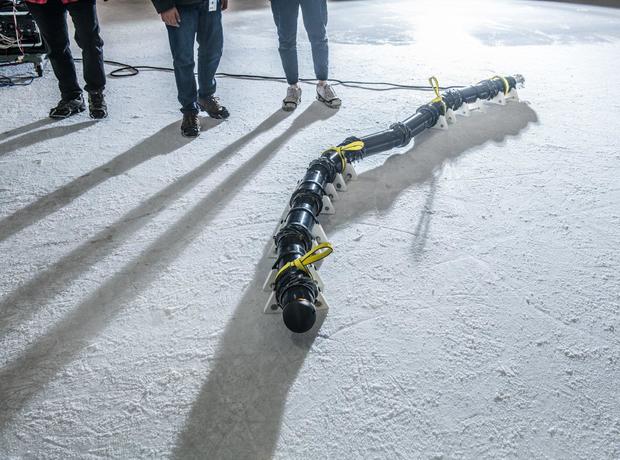NASA is developing a snake-like robot to slither through a Saturn moon in search of life
Is there life outside of Earth? A new snake-like robot could be the one to find out.
The Exobiology Extant Life Surveyor (EELS) is being developed by NASA's Jet Propulsion Laboratory for a space mission to Enceladus, one of Saturn's 83 moons known for its icy surface that's the whitest and most reflective in the solar system. It's believed that there is a liquid ocean under the ice, prompting further investigation into whether life exists within it.
According to the Jet Propulsion Lab, EELS is a "snake-like, self-propelled robot" made of segments with "first-of-a-kind rotating propulsion units" that allow it to grip surfaces and move underwater. The hope is that the robot snake will be able to slither its way through vents on Enceladus' surface to get into the ocean below.
The roughly 16-foot and 220-pound robot is undergoing extensive testing in various environments to make sure it's ready for the job. The "head" of the snake will feature technology that allows EELS to capture the world in 3D and send real-time video to operators. Meanwhile its body will be able to carry and deploy a science payload that could allow scientists to capture subsurface pressure, electrical conductivity and temperature.
Last fall, it underwent testing at the Athabasca Glacier in Canada's Jasper National Park.
A launch date for EELS has not yet been announced, but researchers hope to finalize the EELS concept by fall 2024.
"We are early in the project, but it is achievable in our lifetime," EELS Deputy Project Manager Rachel Etheredge said last year. "...It's an ambitious collaboration, and we're motived by the shared excitement we have for this concept, and the potential science we could gather with EELS."
Once it's ready to go, it would take about 12 years for a spacecraft to carry EELS to the Saturn moon, but researchers hope that it would take only days for the robot snake to reach the ocean once it finds its way into a vent in the icy crust.
"The EELS system is a mobile instrument platform conceived to explore internal terrain structures, assess habitability and ultimately search for evidence of life," NASA says of its development. "It is designed to be adaptable to traverse ocean-world-inspired terrain, fluidized media, enclosed labyrinthian environments and liquids."
And if all goes well, the robot snake could take ocean world exploration to the next level, NASA says, allowing "deeper exploration into areas that were once unattainable."






